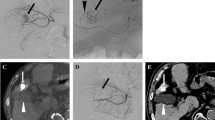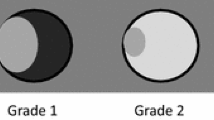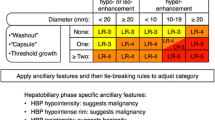Abstract
Objective: The purpose of this study was to describe the characteristic computed tomographic (CT) appearance of iodized-oil retention in hepatic hemangioma and to evaluate the duration of the retention of iodized oil on follow-up CT.
Methods: Seventeen hepatic hemangiomas of 14 patients were studied with CT performed 1–3 weeks after injection of 2–9 ml of iodized oil (iodized-oil CT) for the characterization of focal hepatic lesions, which needed differential diagnosis with hepatocellular carcinoma in 10 patients, for therapy in two patients, and for chemoembolization therapy of accompanying hepatocellular carcinomas in two. Twelve patients had 1–7 follow-up CT scans within an interval of 1–38 months.
Results: In all cases, iodized-oil CT showed iodized-oil retention within the tumor, regardless of tumor size, shape, location, and amount of injected iodized oil. The distribution was incomplete and predominantly peripheral in all cases. Central retention was also seen in seven cases, in which a relatively large amount of iodized oil was injected, but retention of iodized oil in the tumor was incomplete even in two cases in which a large amount of iodized oil was injected to relieve symptoms and in three cases in which prominent uptake of surrounding liver parenchyma was seen. Patterns of retention were predominantly spotty in five, predominantly nodular in four, and mixed in eight patients. Retention materials slowly washed out but persisted for at least 3 months and up to 38 months (mean=18.1 months), and complete washout was not seen in any cases at follow-up CT.
Conclusion: In all cases of hepatic hemangiomas, iodized oil was retained, and retention persisted over several months. Distribution and patterns of retention were characteristically peripheral, spotty, and nodular at iodizied-oil CT. Knowledge of the iodized-oil CT appearance of hepatic hemangioma would be helpful to interpret follow-up CT studies of patients who have undrgone iodized-oil chemoembolization procedures.
Similar content being viewed by others
References
Ishak KG, Rabin L. Benign tumors of the liver. Med Clin North Am 1975;59:995–1012
Emondson HA. Tumors of the liver and intrahepatic bile ducts. In: Atlas of tumor pathology, fasc 25, ser 7. Washington DC: Armed Forces Institute of Pathology, 1958;113–130
Nelson RC, Chezmar JL. Diagnostic approach to hepatic hemangiomas. Radiology 1990;176:11–13
Bree RL, Schwab RE, Glazer GM, et al. The varied appearances of hepatic cavernous hemangiomas with sonography, computed tomography, magnetic resonace imaging and scintigraphy. RadioGraphics 1987;7:1153–1175
Moody AR, Wilson SR. Atypical hepatic hemangioma: a suggestive sonographic morphology. Radiology 1993;188:413–417
Freeny PC, Marks VM. Hepatic hemangioma: dynamic bolus CT. AJR 1986;132:711–719
Iwai K, Maeda H, Konno T. Use of oily contrast medium for selective drug targeting to tumor: enhanced therapeutic effect and x-ray image. Cancer Res 1984;44:2115–2121
Yumoto Y, Jinno K, Tokuyama K, et al. Hepatocellular carcinoma detected by iodized oil. Radiology 1985;154:19–24
Miller DL, O’Leary TJ, Girton M. Distribution of iodized oil within the liver after hepatic arterial injection. Radiology 1987;162:849–852
Merine D, Takayasu K, Wakao F. Detection of hepatocellular carcinoma: comparison of CT during arterial portography with CT after intraarteria injection of iodized oil. Radiology 1990;175:707–710
Choi BI, Park JH, Kim BH, et al. Small hepatocellular carcinoma: detection with sonography, computed tomography (CT), angiography and Lipiodol CT. Br J Radiol 1989;62:897–903
Choi BI, Kim HC, Han JK, et al. Therapeutic effect of transcatheter oily chemoembolization therapy for encapsulated nodular hepatocellular carcinoma: CT and pathologic findings. Radiology 1992;182:709–713
Park CH, Suh JH, Yoo HS, et al. Iodine-131-labeled iodized oil retention within hepatic cavernous hemangioma. Radiology 1987; 163:283–284
Uflacker R, Mourao GS, Piske RL. Iodized oil retention within hepatic cavernous hemangioma. Cardiovasc Intervent Radiol 1989;12:76–79
Itai Y, Ohnishi S, Ohtomo K, et al. Hepatic cavernous hemangioma in patients at high risk for liver cancer. Acta Radiol 1987;28:697–701
Therasse E, Breittmayer F, Roche A, et al. Transcatheter chemoembolization of progressive carcinoid liver metastasis. Radiology 1993;189:541–547
Freeny PC, Vimont TR, Barnett DC. Cavernous hemangioma of the liver: ultrasonography, arteriography and computed tomography. Radiology 1979;132:143–148
Ohtomo K, Itai Y, Yoshida H, et al. MR differentiation of hepatocellular carcinoma from cavernous hemangioma. AJR 1989;152:505–507
Birnbaum BA, Weinreb JC, Megibow AJ, et al. Definite diagnosis of hepatic hemangioma: MR imaging versus Tc-99m-labeled red blood cell SPECT. Radiology 1990;176:95–101
Choi BI, Han MC, Kim WC. Small hepatocellular carcinoma versus small cavernous hemangioma: differentiation with MR imaging at 2.0 T. Radiology 1990;176:103–106
Choi BI, Han MC, Park JH, et al. Giant cavernous hemangioma of the liver: CT and MR imaging in 10 cases. AJR 1989; 152:1221–1226
McLoughlin MJ. Angiography in cavernous hemangioma in liver. AJR 1971;113:50–55
Takayasu K, Moriyama N, Shima Y, et al. Atypical radiographic findings in hepatic cavernous hemangioma: correlation with histological features. AJR 1986;146:1149–1153
Stark DD, Felder RC, Wittenberg J, et al. Magnetic resonance imaging of cavernous hemangioma of the liver: tissue-specific characterization. AJR 1985;145:213–222
Wittenberg J, Stark DD, Forman BH. Differentiation of hepatic metastases from hepatic hemangiomas and cysts by using MR imaging. AJR 1988;151:79–84
Taylor KJW, Ramos I, Morse SS, et al. Focal liver masses: differential diagnosis with pulsed Doppler sonography. Radiology 1987;164:643–647
Kudo M, Tomita S, Tochio H, et al. Sonography with intraarterial injection of carbon dioxide microbubbles (sonographic angiography): value in differential diagnosis of hepatic tumors. AJR 1992;158:65–74
Author information
Authors and Affiliations
Rights and permissions
About this article
Cite this article
Moon, W.K., Choi, B.I., Han, J.K. et al. Iodized-oil retention within hepatic hemangioma: characteristics on iodized-oil CT. Abdom Imaging 21, 420–426 (1996). https://doi.org/10.1007/s002619900096
Received:
Accepted:
Issue Date:
DOI: https://doi.org/10.1007/s002619900096




